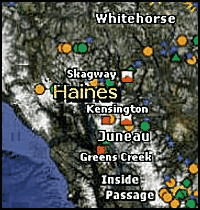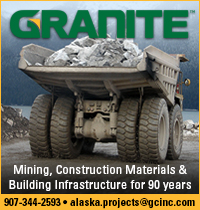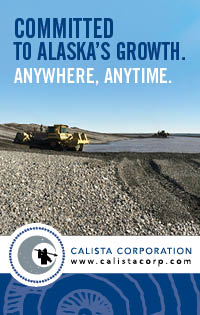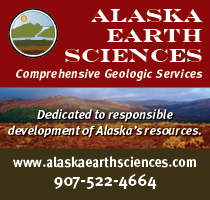MINING NEWS: Pebble will face determined dam busters
 Click here to go to the full PDF version of this issue, with any maps, photos or other artwork that appears in
some of the articles. Click here to go to the full PDF version of this issue, with any maps, photos or other artwork that appears in
some of the articles.
Permitting the largest dam in North America for proposed Alaska copper-gold mine will be a lengthy and controversial process
Sarah Hurst For Mining News
Nothing’s been built yet, but Vancouver-based Northern Dynasty has already opened the floodgates to a torrent of discussion of the enormous dams the company proposes for the Pebble project. One of the tailings dams would reach an ultimate height of 740 feet and would be at least 4.3 miles long. The largest dam in North America, the Grand Coulee Dam in Washington, is 550 feet tall and almost a mile long.
Northern Dynasty had already come under fire before it submitted the proposal for five dams to Alaska’s Department of Natural Resources. The Renewable Resources Coalition, a nonprofit organization that is devoting strenuous efforts to oppose the Pebble project, published a report that responded negatively to Northern Dynasty’s revised water rights application, also submitted by the company to DNR recently.
The report is “a cynical attempt to masquerade anti-development politics as science,” said Northern Dynasty’s COO, Bruce Jenkins. “In its rush to judgment, the RRC didn’t even see fit to look at the information contained in our most recent submission,” he added. “More to the point, they’re reviewing these preliminary applications as if they are intended to fully describe the copper mine that Northern Dynasty is proposing to build at Pebble. This is a patently false premise upon which to assess these documents, and the RRC and its consultant have taken the opportunity to reach unfounded conclusions that are calculated to mislead and alarm Alaskans.”
Report by Coble Geophysical Services Homer-based Coble Geophysical Services wrote the 4 1/2-page report for the RRC. The report asserted that the proposed diversions of surface water and groundwater from the Upper Talarik will create dry riverbeds, eliminating Sockeye spawning and Coho rearing habitat. “If sufficient water is not diverted to submerge tailings ... oxidation of mining waste can become a serious problem,” the report also said. “Contaminated reservoir water discharged to the Tailings Storage Facility Reservoir could flow underground from the South Fork Koktuli Watershed into the Upper Talarik Creek Watershed,” it added.
The true costs of reclamation of the Pebble project may never be quantified, the report went on. “The remote location makes regulation more expensive and difficult, even if the fees are addressed during the mine’s life through water rights fees,” it said. “Problems obviously can occur after ceasing water use. It is hard to predict who will regulate mine reclamation activity so far into the future (50 years). The state of Alaska does not generally plan that far ahead.”
Northern Dynasty: $42 million on environmental studies “We have invested more than $42 million on environmental studies to date in order to establish the scientific foundation necessary to design a mine that can operate safely while preserving clean water, healthy fisheries and other natural values that Alaskans value,” Northern Dynasty’s Jenkins said. “We will continue in those efforts with the goal of submitting a comprehensive mine plan proposal in 2008 for the review and scrutiny of government agencies and the people of Alaska.”
Mining companies routinely file for water rights, according to Tom Crafford, large mine permitting manager at DNR, but it is unusual to file so far in advance of the mine permit applications, he said. Northern Dynasty has asked DNR to postpone its review of the water rights application until the other mine permit applications are submitted. The company expects the permitting process to take around three years, starting in 2008.
Engineering and environmental consulting company Knight Piésold produced the tailings facility documents that formed part of Northern Dynasty’s water application. The possible sites for the two tailings impoundments that are considered the least environmentally sensitive are a tributary of the upper South Fork Koktuli River area, a tributary of the North Fork Koktuli River, and along the upper reaches of the South Fork Koktuli River Basin, immediately adjacent to the proposed open pit mine development.
Pebble dams will have to meet state guidelines Charles Cobb, the dam safety specialist at DNR, will be responsible for ensuring that the Pebble dams adhere to a 230-page set of state guidelines. For a project of this magnitude he will form a design review board, with specialists in geotechnical, hydrological and structural engineering, Cobb told Mining News. “It’s really old-school engineering,” he said. “The Hoover Dam is an exceptionally safe dam, so the concept of building a safe dam is nothing new.”
Seismic studies that Northern Dynasty must undertake will determine what size of earthquake the dams should be able to withstand, depending on the faults in that particular area of the Bristol Bay region. Even if there is a major earthquake, the dams won’t fail catastrophically; more likely there will be deformation of the structures, Cobb said. The largest dam in Alaska at present, the tailings dam at Fort Knox gold mine near Fairbanks, was “completely unaffected” by the magnitude 7.9 earthquake that ruptured the Denali fault in November 2002, he added. That dam is over 4,000 feet long and 320 feet high.
Overseeing tailings facility when mine closes another issue Another issue for Northern Dynasty and DNR to deal with is how to oversee the tailings facility when the mine closes. This is a pressing question for Fort Knox, too, since that mine is due to close within the next few years. So far the mine has provided $1 million to maintain the tailings dam after closure, according to Cobb, but a decision hasn’t been taken as to whether the state or the mining company, Kinross, will be responsible for looking after the money. Red Dog lead-zinc mine in Alaska’s Arctic also has a tailings facility that will require dam maintenance and water treatment in perpetuity.
The failure rate for tailings dams is statistically higher than for water dams, according to the State of Alaska’s guidelines for cooperation with the Alaska Dam Safety Program. The guidelines illustrate this point with a quote from “Tailings Dam Failures — the Human Factor” by Alan H. Gipson, written in 2003. “When compared to water dams the current failure rate of tailings facilities is unacceptable,” Gipson wrote. “In my view the primary reason for the failure rate is that owners, engineers, designers and operators are not performing their work in accordance with the standards of practice that should be followed. Utilizing knowledgeable experienced professionals for policy setting, planning, design, construction and operation of tailings facilities ... can lead to the goal of zero failures.”
In November 2004 a tailings dam collapsed during reclamation work at Teck Cominco’s closed Pinchi Lake mercury mine in British Columbia. The accident released between 6,000 and 8,000 cubic meters of rock, dirt and waste water into Pinchi Lake. As a result, the Tl’azt’en First Nation announced a moratorium on new mining on its traditional territory. The impact to Pinchi Lake was “minor and very short term,” according to Teck Cominco.
|

 Click here to go to the full PDF version of this issue, with any maps, photos or other artwork that appears in
some of the articles.
Click here to go to the full PDF version of this issue, with any maps, photos or other artwork that appears in
some of the articles.







